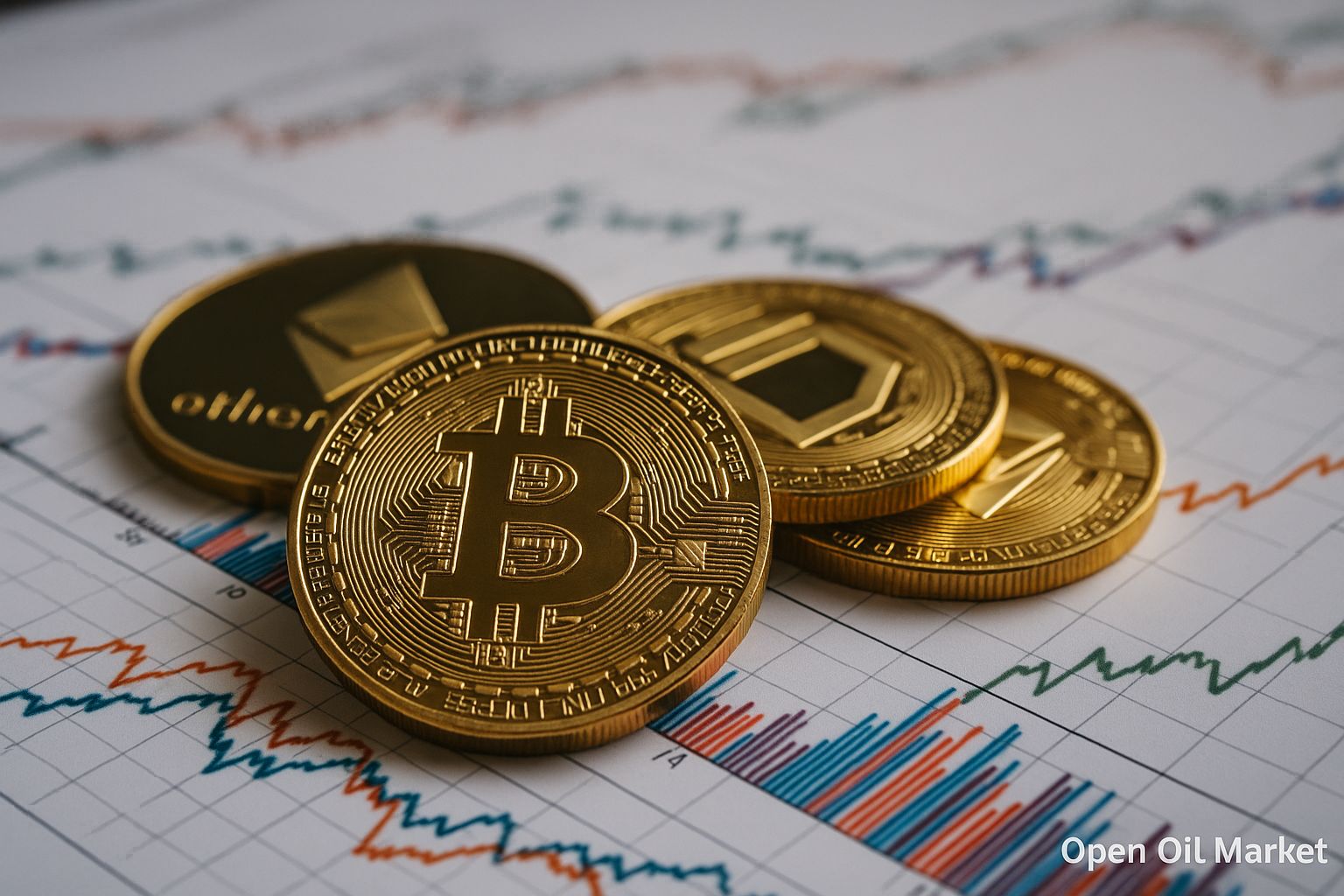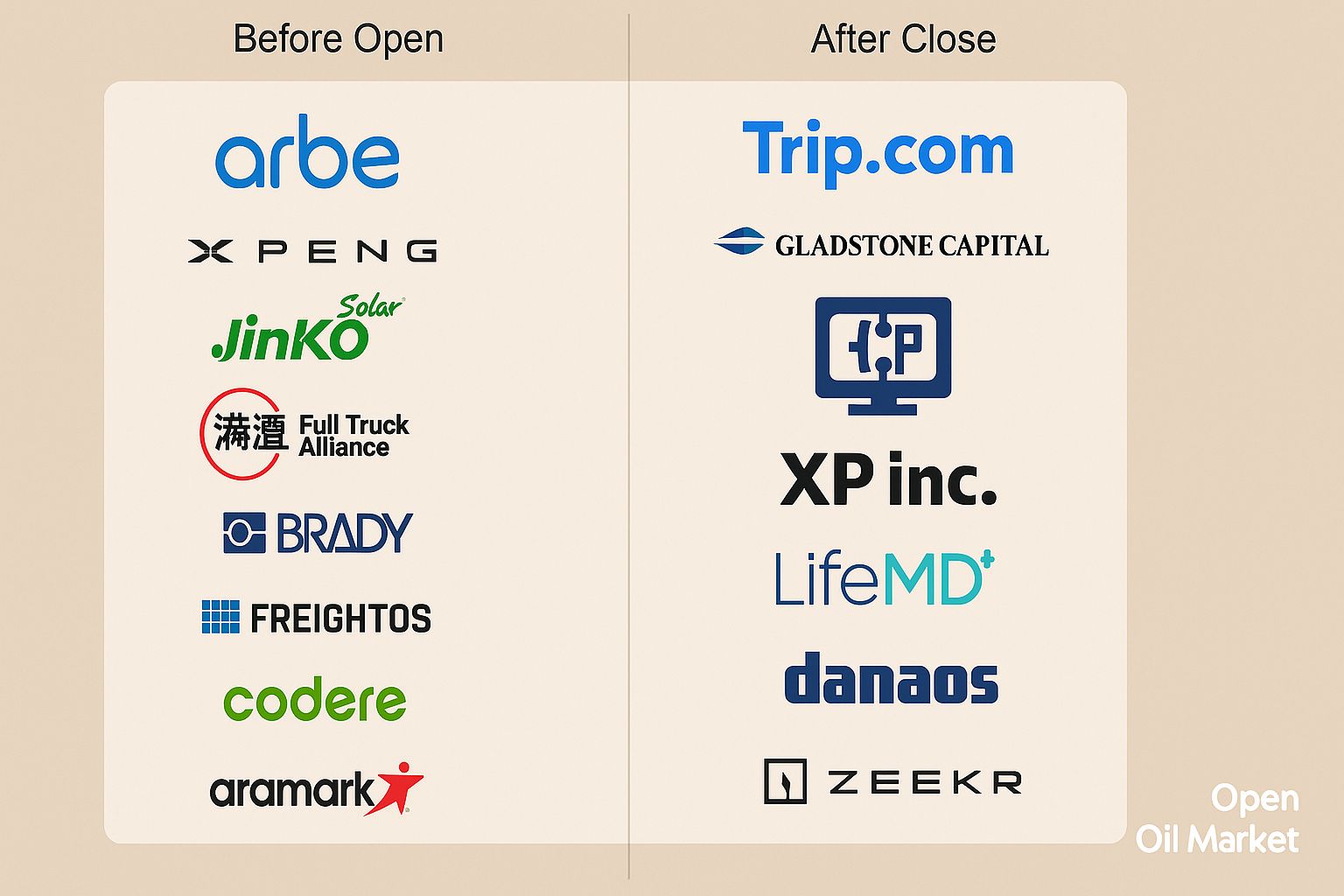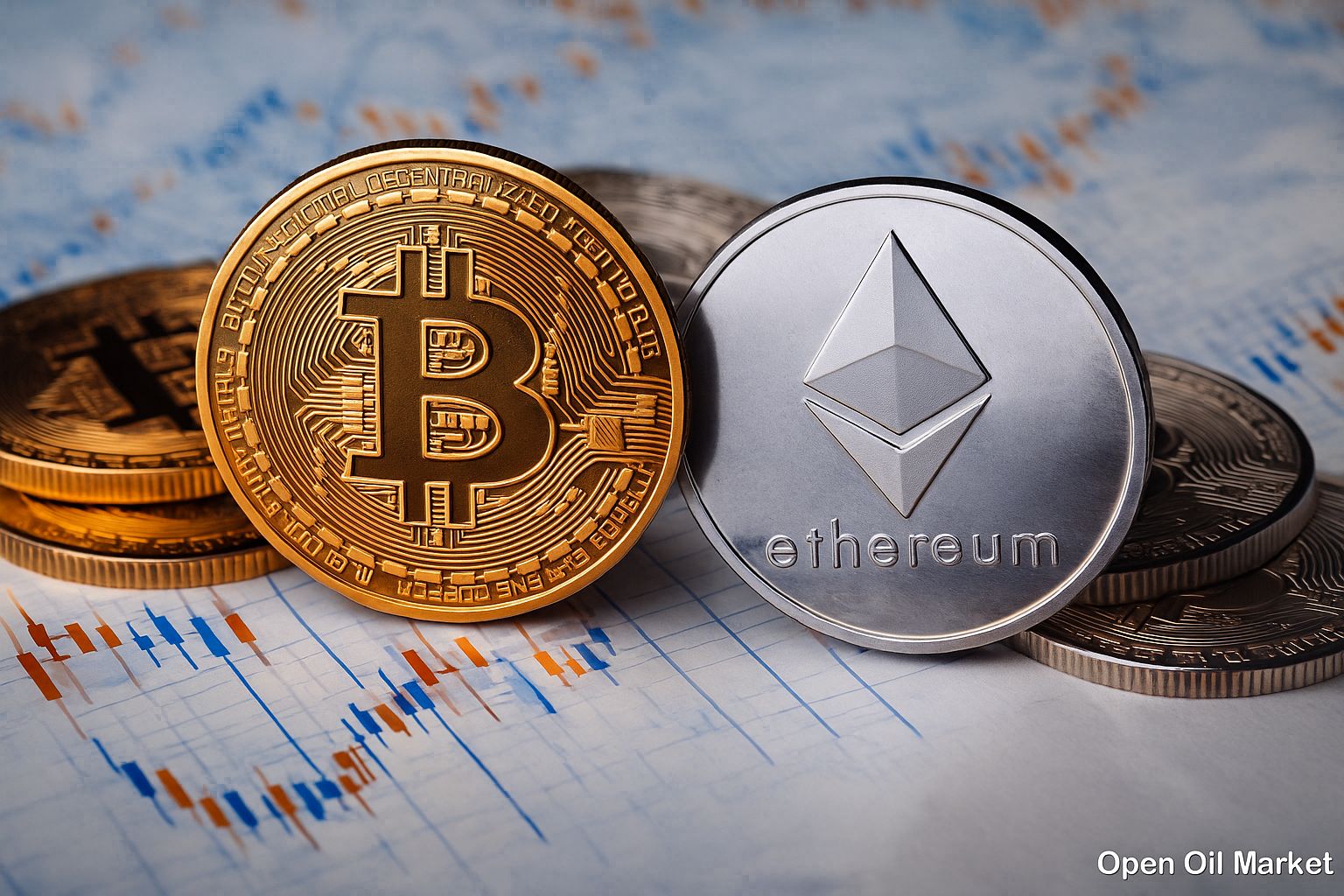
Latest Cryptocurrency News as of 15 October 2025: Bitcoin Maintains Above $110,000 After Correction, Ethereum Stable Around $4,000, Altcoins Show Mixed Dynamics. Investors Hope for a Federal Reserve Policy Shift; Review of the Top 10 Popular Cryptocurrencies, Institutional Trends, and Market Sentiment.
Bitcoin Stabilises After Volatile Correction
By the morning of 15 October 2025, the flagship cryptocurrency Bitcoin (BTC) is trading around $115,000, recovering from a sharp decline over the weekend. In the first week of the month, BTC managed to set a new historical peak, exceeding the $130,000 mark due to the "Uptober" effect and record inflows into crypto funds. However, the announcement of a 100% tariff on imports from China by the US triggered a swift sell-off of risk assets: Bitcoin's price instantaneously dropped nearly 15%, falling to approximately $107–110,000, before finding support. The current price remains significantly above levels from last month, with BTC's market capitalisation estimated at around $2.3–2.4 trillion (≈60% of the total market).
Despite the recent volatility, the fundamental factors for Bitcoin remain favourable. The US Federal Reserve signalled its readiness to adopt a more accommodative monetary policy: Jerome Powell's speech this week reinforced expectations of an interest rate reduction at the meeting scheduled for late October. The prospect of cheap money bolsters demand for "digital gold." Furthermore, the regulatory environment in the US remains positive – the administration continues to maintain a cryptocurrency-friendly stance, having previously allowed BTC to be included in pension plans and initiating the establishment of a government crypto reserve. Large corporations are also undeterred: MicroStrategy and other public companies recently added Bitcoin to their holdings during the dip, demonstrating long-term confidence. Many analysts remain optimistic: investment banks JPMorgan and Standard Chartered continue to forecast BTC growth to $150,000–200,000 by year-end if macro trends (low inflation and easing Fed policy) persist.
Ethereum Retracts from Peak but Holds Ground
Following Bitcoin, Ethereum (ETH) has also experienced volatility. During the rally in early October, the second-largest cryptocurrency by market capitalisation reached a historical maximum above $4,900 for the first time since 2021. However, a correction followed the record peak: amidst a general market downturn, Ethereum retreated approximately 15% and has now stabilised around $4,000. Despite the decline, the current ETH price is still close to previous highs, with a market capitalisation of about $500–520 billion (≈13% of the market). Ethereum continues to enjoy increased demand due to its key role in DeFi and NFT ecosystems, maintaining its status as the leading altcoin.
Long-term prospects for Ethereum are viewed positively by experts. A technical upgrade named "Fusaka" is expected in October, aimed at enhancing blockchain scalability and security. Investors are also eagerly anticipating the launch of the first spot ETF on Ethereum – market speculation suggests that the US Securities and Exchange Commission may approve such a fund in the coming weeks. Institutional interest in ETH is evidenced by record levels of derivatives: open interest in Ethereum futures on the CME exchange reached an all-time high at the start of the month (equivalent to over $11 billion). All of this points to confidence among major players in Ethereum's further growth following the current consolidation.
Altcoins: Mixed Dynamics and Search for Drivers
The altcoin market as of mid-October shows a divergent movement. After a broad rise at the beginning of the month (the "altseason" index exceeded 70 points), some alternative coins have encountered heightened volatility. Many large altcoins are still trading significantly higher than a month ago; however, the recent correction has impacted the more speculative assets. Over the weekend, the total capitalisation of altcoins decreased by approximately $200 billion due to waves of margin liquidations in the market (it is estimated that over $19 billion in trading positions were liquidated). Some mid-tier tokens saw declines of 50–80%, highlighting liquidity risks and poor risk management on certain exchanges.
Nevertheless, several altcoin leaders have managed to hold near their highs. For instance, Solana (SOL) exhibited relative resilience: its price even rose to $200 amidst the overall correction (+4% over the day, while other top coins were in the red). Investors maintain belief in Solana's potential due to speculation regarding the possible approval of the first ETF on SOL and the development of the project ecosystem on this high-performance blockchain platform. The Ripple (XRP) token, following a summer surge, is consolidating around $2.5, remaining in the top five by capitalisation – Ripple's legal victory in a US court has alleviated regulatory uncertainties, allowing XRP to trade significantly higher than it did a year ago. Conversely, some coins popular in previous months, such as Cardano (ADA) and Dogecoin (DOGE), have seen declines of 20–30% from recent peaks in recent days, correcting their robust growth in September. Overall, Bitcoin's share of total capitalisation has increased to ~60%, reflecting a shift of some capital back into BTC during turbulent times – a classic picture of a temporary cooling off of the "altseason."
Institutional Trends: Caution Amidst Confident Interest
Major institutional investors as of mid-October are demonstrating mixed signals. On one hand, following the recent correction, outflows have been recorded from certain crypto ETFs: in the first few days of the week, the total outflow of capital from spot funds for Bitcoin and Ethereum exceeded $750 million, indicating short-term profit-taking and heightened caution. At the same time, the overall presence of institutions in the market continues to grow. In 2025, US regulators have already approved several spot cryptocurrency funds, broadening access for large investors to digital assets. It is anticipated that new ETFs on various altcoins could receive approval by year-end – discussions are ongoing regarding funds for XRP and Solana.
Furthermore, the integration of cryptocurrencies into traditional financial infrastructure continues. Major exchanges and banks are announcing new services: 24/7 trading of crypto derivatives is being launched in international markets, and some fintech companies are implementing stablecoin payments. For instance, in the US, the fintech bank Brex has begun supporting transactions in USDC, while several regional banks are experimenting with the issuance of their own stablecoins to expedite interbank payments. These steps, alongside the global implementation of regulatory frameworks (the MiCA law has come into effect in the EU, while licensing regulations for stablecoins are being introduced in Hong Kong), strengthen trust in the industry. Overall, institutional and corporate players have not scaled back their crypto projects: on the contrary, there is an acceleration in investments in blockchain startups and infrastructure. While some funds are realising profits amidst volatility in the short-term, the strategic interest of large capital in cryptocurrencies remains upward.
Market Sentiment and Volatility
The sharp price fluctuations of recent days have reflected in sentiment indicators. The "Fear and Greed Index" for the crypto market, which reached the "Greed" zone (above 70 points) earlier in the month, has now retreated to neutral territory (~50 points). This indicates that the initial euphoria has somewhat dissipated following the correction, and investors have become more restrained. Nevertheless, there are no signs of panic – the market has quickly processed the shock from trading news, and a baseline optimism remains. Trading volumes remain high ($200+ billion per day), indicating ongoing active repositioning among participants.
Experts highlight that the market's cleansing of excessive leverage and speculative positions that occurred during the volatility may lay the groundwork for more sustainable growth ahead. The liquidation of overheated positions has improved the situation for long-term investors by reducing some risks of sudden downturns. At the same time, traders should be prepared for heightened price fluctuations moving forward: geopolitical factors (US-China trade disputes) and expectations surrounding central banks' actions can still trigger rapid volatility spikes. In the short term, markets will be closely monitoring Fed statements and macroeconomic data – any surprises could either accelerate a new rally or provoke another round of correction.
Forecasts and Expectations
Despite the recent pullback, many analysts maintain favourable forecasts for cryptocurrencies through the end of 2025. The bullish consensus is supported by expectations of eased monetary policy: potential rate cuts from the Fed and other central banks could drive new waves of capital into higher-yield assets, including Bitcoin and Ethereum. Several investment firms have revised their price targets for BTC upwards – some major banks are suggesting a range of $150,000–180,000 within the next 3–6 months. For Ethereum, optimistic scenarios envision movement towards the $6,000 mark, especially if the ETF launches and network upgrades are successfully executed.
Conversely, cautious voices warn that the path to new highs will not be straightforward. There may be recurring cycles of heightened volatility as Bitcoin approaches psychologically significant levels (e.g., $130k and $150k). Should the geopolitical situation worsen or if there are delays in central bank stimulus measures, the market may remain flat or deepen its correction. Nevertheless, history shows that significant downturns in the cryptocurrency market are often followed by swift recoveries. Investors are advised to maintain a balanced strategy: diversify their portfolio, avoid emotional selling during panic, and focus on fundamental long-term trends. The overall outlook from experts for the medium to long term remains positive – the cryptocurrency sector, having weathered short-term fluctuations, retains every chance of finishing the year on a high note.
Top 10 Most Popular Cryptocurrencies
As of the morning of 15 October 2025, the ten largest and most popular digital assets by market capitalisation include the following cryptocurrencies:
- Bitcoin (BTC) – the first and largest cryptocurrency. BTC is trading around $115,000 after a recent correction (historical high was ~$130,000 earlier in October). Bitcoin's market capitalisation is approximately $2.3 trillion, accounting for ~60% of the total cryptocurrency market capitalisation. Bitcoin retains its status as "digital gold" and a barometer of overall market sentiment.
- Ethereum (ETH) – the leading altcoin and primary platform for smart contracts. ETH is priced approximately at $4,100, slightly below record levels ($4,900 during the past weekend). Ethereum's capitalisation is about $500 billion (≈13% of the market). It serves as the foundation for DeFi, NFT, and numerous dApps, solidifying its position as number two in the industry.
- Binance Coin (BNB) – the exchange token of the largest cryptocurrency exchange Binance and the native coin of the BNB Chain ecosystem. BNB is currently priced around $1,150, having surpassed $1,200 earlier this month to reach a historical maximum. The market value of BNB is estimated at $180 billion. Despite regulatory pressure on Binance, the broad applicability of BNB (payment of fees, DeFi, NFT) supports its presence in the top three.
- Tether (USDT) – the largest stablecoin pegged to the US dollar at a 1:1 ratio. USDT is widely used for trading and capital inflows and outflows in the cryptocurrency markets. Its capitalisation is around $170 billion, with a stable price maintained at $1.00 (≈78–79 ₽ at the current exchange rate). The USDT stablecoin plays a critically important role in the ecosystem, ensuring liquidity and risk hedging.
- XRP (XRP) – the token of the Ripple payment network, designed for cross-border transactions. XRP is trading around $2.5, with a market capitalisation of approximately $130 billion. In 2025, XRP significantly increased in price due to winning a lawsuit against the SEC in the USA, reaffirming the non-security status of the token. Despite recent volatility adjusting the price from peaks of ~$3, XRP remains among the top five, and legal clarity contributes to investor interest.
- Solana (SOL) – a high-speed blockchain for decentralised applications and DeFi. SOL is trading around $200 per coin (capitalisation ~ $100 billion), having recovered to late 2021 levels. Solana attracts attention for its growing ecosystem of projects and speculations regarding the potential launch of an ETF on SOL. The coin demonstrates strong performance, remaining one of the fastest-growing platforms.
- USD Coin (USDC) – the second-largest stablecoin backed by USD reserves (issued by Circle). The USDC price is tightly pegged to $1.00, with a capitalisation of around $65–70 billion. USDC is popular among institutional investors and in DeFi due to transparent reserves and regulated status. It plays an important role in liquidity pools and settlements between cryptocurrency exchanges.
- Dogecoin (DOGE) – the most renowned meme cryptocurrency, originating as a joke. DOGE is trading near $0.19 (capitalisation ~ $28–30 billion) after a correction from September peaks. The coin remains in demand due to its dedicated community and periodic attention from notable businessmen. Despite high volatility, Dogecoin holds its place in the top ten, displaying remarkable resilience of investor interest in this "meme" asset.
- Cardano (ADA) – a blockchain platform evolving with a scientific approach to technology implementation. ADA is trading around $0.66 (capitalisation ~ $25–30 billion), correcting from $1.00 a month ago. The project draws attention with plans for further network development (including a potential own ETF that is currently being discussed in the market) and an active community that believes in Cardano's long-term potential.
- TRON (TRX) – a platform for smart contracts and decentralised entertainment, particularly popular in Asia. TRX is holding around $0.30; its market capitalisation is approximately $30 billion. TRON retains its place in the top ten in large part due to the widespread use of its network for issuing stablecoins – a significant portion of USDT is issued on the TRON blockchain due to low fees. The TRON ecosystem continues to evolve, ensuring steady demand for the coin.
The Cryptocurrency Market on the Morning of 15 October 2025
- Major Cryptocurrency Prices: Bitcoin (BTC) — $114,000; Ethereum (ETH) — $4,200; XRP — $2.45; BNB — $1,180; Solana (SOL) — $200; Cardano (ADA) — $0.70.
- Market Indicators: Total cryptocurrency market capitalisation ~ $4.0 trillion; Bitcoin's share ≈ 60.5%; Fear and Greed Index = 55 (neutral sentiment).
- Leaders in Daily Changes: growth – Toncoin (TON) +9%; decline – Zcash (ZEC) –19%.
- Analysis: Bitcoin and Ethereum are consolidating around current levels following volatile sessions, indicating a market calming. The sentiment index has returned to neutral levels – investors have absorbed recent events and adopted a cautious stance. TON has notably led the growth, drawing attention with positive news about its ecosystem, while ZEC's decline reflects local profit-taking and low liquidity on certain exchanges. Overall, the cryptocurrency market demonstrates resilience: key metrics remain healthy, and investor interest is high, creating a foundation for a potential new rally following this period of stabilisation.




